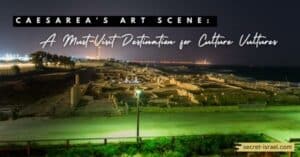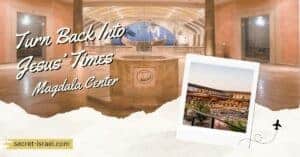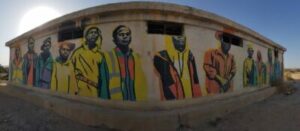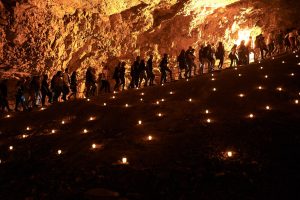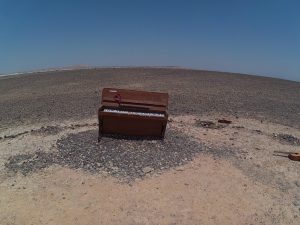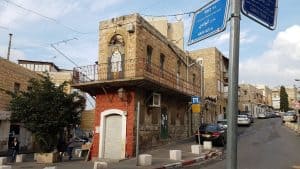Step into Israel’s past and discover the rich history and cultural heritage of the land. From the ancient city of Jerusalem to the Roman City of Caesarea. Israel is home to a diverse range of historical sites that offer a glimpse into the past. Explore the archaeological wonders of the Tel Megiddo and uncover the secrets of the Dead Sea Scrolls.
Are you looking for a unique way to explore Israel’s fascinating history and culture? Visiting historical sites in Israel is the perfect way to do just that! From uncovering the secrets of the Dead Sea Scrolls to venturing out to Tel Megiddo. In the ancient city of Jerusalem and Roman Caesarea, there are plenty of incredible sites to explore.
Exploring the Ancient City of Jerusalem
This a unique opportunity to gain a deeper understanding of the religious and cultural significance of one of the most important cities in the world. Jerusalem is consider a holy city for Jews, Christians, and Muslims. Home to several significant historical sites that offer a glimpse into the past.
Historical Sites in Jerusalem
The City of Jerusalem is home to some of the most important religious and historical sites in the world. From the Western Wall, Al-Aqsa Mosque, and Dome of the Rock to King David’s Tomb and Church of the Holy Sepulchre, there are plenty of amazing sites to explore.
Visit these places and gain a deeper understanding of the significance of these sites. Discover the history, culture, and religion that influenced them.
The Western Wall
Also known as the Wailing Wall, which is a remnant of the Second Temple. This site is considered the holiest place in the Jewish religion. Thousands of Jewish people visit the wall to pray and place notes with prayers between the stones.
Address: Western Wall Plaza Jewish Quarter, Jerusalem 97500 Israel
Opening Hours: Open 24 hours
Phone: +972 2-627-1333
Navigate here to see the location’s actual view.
The Dome of the Rock
Which is an Islamic shrine located on the Temple Mount. It is believe to be the site where the Prophet Muhammad ascended to heaven during his Night Journey. The Dome of the Rock is also an important site for Jews, as it is believe to be the location of the First and Second Temples.
Address: Temple Mount (Haram al-Sharif), Jerusalem
Opening Hours:
Temple Mount is closed to tourists on Fridays, Saturdays, and during Muslim holidays.
(Sometimes Temple Mount can close without notice.)
For non-Muslim visitors, Temple Mount can be visited Sunday through Thursday:
- Summer: April through September: 8:30am – 11:30am and 1:30pm – 2:30pm
- Winter: October through March: 7:30am – 10:30am and 12:30pm – 1:30pm
Entrance Fee: Admission is free
Navigate here to see the location’s actual view.
The Church of the Holy Sepulchre
Is also an important historical site in Jerusalem. As it is believed to be the location of Jesus’ crucifixion, burial, and resurrection. This church is one of the most important pilgrimage destinations for Christians, as well as for other religious groups.
Address: Christian Quarter, Jerusalem, Israel
Opening Hours: 05:00am – 09:00pm
Phone: +972-6273314
Entrance Fee: Admission is free
Navigate here to see the location’s actual view.
In addition to these well-known sites are the City of David, the Tower of David, and the Mount of Olives. That offer a glimpse into the past of the city and its people.
Uncovering the History of the Dead Sea Scrolls
The Dead Sea Scrolls are a collection of Jewish texts that were discovered in the 1940s in the caves of Qumran, near the Dead Sea. These texts which date back to the 2nd century BC. Include some of the oldest known manuscripts of the Hebrew Bible as well as other Jewish texts such as hymns, wisdom literature, and apocalyptic visions.
The discovery of the Dead Sea Scrolls was a major archaeological and historical find. As it provided insight into the beliefs and practices of a Jewish sect known as the Essenes. Who lived in the area around the Dead Sea during the Second Temple period. The scrolls also offer a glimpse into the diversity of Jewish beliefs and practices during this time. As they contain texts that reflect different interpretations of Jewish law and tradition.
The scrolls contain texts that are similar to those found in the Hebrew Bible, as well as texts that are not found in the Hebrew Bible. This can provide insight into the different beliefs and practices of Jewish sects at the time, and how these sects influenced the development of early Christianity.
The scrolls can be view today at the Israel Museum in Jerusalem, where some of the most well-preserved scrolls and artifacts are on display. Additionally, visiting the site of Qumran, where the scrolls were found, can provide an understanding of the historical context of the scrolls and the sect that wrote them.
Address: Derech Ruppin 11, Jerusalem
Opening Hours:
- Monday 10 am–5 pm
- Tuesday 4–9 pm
- Wednesday 10 am–5 pm
- Thursday 10 am–5 pm
- Friday 10 am–2 pm
- Saturday 10 am–5 pm
- Sunday 10 am–5 pm
Phone: 02-670-8811
Email: [email protected]
Admission Fee: ₪54.00
For pictures, booking, and more information, click here.
Venturing to the Roman City of Caesarea
Caesarea was a major port city and administrative center during the Roman period, and it was build by King Herod the Great in honor of the Roman Emperor Augustus.
The Roman City of Caesarea is located on the Mediterranean coast of Israel and it was an important center of trade and commerce during the Roman period. The city was also an important center of Roman culture, and it had a theater, an amphitheater, and a hippodrome for public entertainment.
One of the main reasons to visit Caesarea is to explore the ancient ruins of the city, which provide a glimpse into the daily life of the people who lived there. The ruins include a theater, an amphitheater, a hippodrome, public buildings, and a palace that belonged to King Herod. Visitors can also see the remains of a Roman aqueduct, a harbor, and a lighthouse.
Another reason to visit Caesarea is to gain a deeper understanding of the Roman Empire and its impact on the region. The city was an important center of Roman culture, and it had a theater, an amphitheater, and a hippodrome for public entertainment. Visitors can also see the remains of a Roman aqueduct, a harbor, and a lighthouse, which demonstrate Roman engineering skills and their influence in the region.
It was an early center of Jewish culture and it was also the home of the apostle Paul, who converted many of its inhabitants to Christianity.
Address: Caesarea
Opening Hours:
- Summer hours:
Sunday–Thursday and Saturday: 17:00 – 08:00
Friday and holiday eves: 16:00 – 08:00
- Winter hours:
Sunday–Thursday and Saturday: 16:00 – 08:00
Friday and holiday eves: 15:00 – 08:00
Phone: 04-626-7080
Admission Fee: ₪20.00 – ₪39.00
For pictures, booking, and more information, click here.
Unearthing the Secrets of the Tel Megiddo Archaeological Site
Tel Megiddo, also known as “Armageddon” is located in the Jezreel Valley in Israel, and it has been identify as one of the most important archaeological sites in the region. The site has been occupied for over 5,000 years and has been destroyed and rebuilt many times, making it an important source of information about the history of the region.
The Tel Megiddo archaeological site is known for its well-preserve remains of the ancient city, including fortifications, water systems, and palaces. Visitors can see the remains of a palace that dates back to the 18th century BC, which is believed to have been built by the Egyptian pharaoh Thutmose III. The site also includes the remains of a city gate and a monumental stairway that dates back to the 9th century BC, which is believed to have been built by the Israelite king Ahab.
Another reason to visit Tel Megiddo is to gain a deeper understanding of the history and culture of the ancient Near East and the biblical world. The site was identified as one of the most important archaeological sites in the region, and it was occupied for over 5,000 years. The remains of the ancient city provide a glimpse into the daily life of the people who lived there, as well as the political and cultural influences that shaped the region.
The site is mentioned in the Bible and is believe to be the location of the final battle between the forces of good and evil, as described in the Book of Revelation.
Address: Megiddo, 18230
Opening Hours:
- Saturday – Thursday 8 am–4 pm
- Friday 8 am–3 pm
Phone: 04-659-0316
Navigate here to see the location’s actual view.
Pros and Cons of Visiting Historical Sites in Israel
| Pros | Cons |
| Provides a deeper understanding of the history and culture of the region | Can be physically demanding as some sites are located on hilly terrain |
| Offers the opportunity to see well-preserved historical artifacts and ruins | Crowds of tourists can make it difficult to fully appreciate the sites |
| Gives insight into the daily lives of people from the past | It might not be possible to properly restore or maintain all sites. |
| Offers the chance to explore religious and cultural significance of the sites | Some sites may have limited opening hours or be close for maintenance |
| Can be educational and informative experience | Some sites may require an entry fee or guided tour |
Tips for Visiting Historical Sites in Israel
- Research the sites you plan to visit in advance. Knowing the history and significance of each site will enhance your experience.
- Plan your visit accordingly. Some sites may have limited opening hours or be close for maintenance. Make sure to check the schedule before you go.
- Wear comfortable shoes and clothing. Some historical sites are located on hilly terrain, and you will be doing a lot of walking.
- Bring sunscreen, water, and snacks, especially in the summer season.
- Consider taking a guided tour. Guided tours can provide valuable information and context about the sites you are visiting.
- Respect the sites by not climbing on ruins or touching artifacts.
- Be ready for a crowd. Some sites can be popular tourist destinations, so plan your visit accordingly to avoid peak crowds.
- Take note of the cultural and religious significance of the sites, and act accordingly.
- Bring your camera, but be respectful of other visitors when taking pictures.
- Be mindful of the current political and security situation in the country before you go. And follow any advice or guidelines issued by the government or local authorities.
In conclusion
Visiting historical sites in Israel can be a rewarding and fascinating experience. From the Western Wall and Dome of the Rock to Tel Megiddo and Caesarea. Visitors have an opportunity to gain a deeper understanding of the history and culture of one of the world’s most storied places.
Whether you are interested in exploring ancient ruins, uncovering the secrets of the Dead Sea Scrolls. Or simply taking in the beauty and significance of these sites, there is something for everyone to experience.
By researching each site beforehand, wearing comfortable clothing and shoes. Being respectful of other visitors and cultures, and keeping safety precautions in mind. You can ensure that your visit is both educational and enjoyable. So come explore and uncover the secrets of historical sites in Israel!









